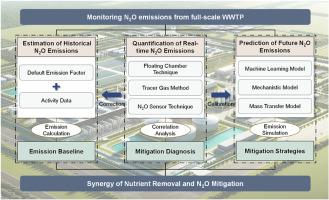当前位置:
X-MOL 学术
›
J. Environ. Manag.
›
论文详情
Our official English website, www.x-mol.net, welcomes your feedback! (Note: you will need to create a separate account there.)
Direct and indirect monitoring methods for nitrous oxide emissions in full-scale wastewater treatment plants: A critical review
Journal of Environmental Management ( IF 8.7 ) Pub Date : 2024-04-09 , DOI: 10.1016/j.jenvman.2024.120842 Zhenxin Shang , Chen Cai , Yanli Guo , Xiangfeng Huang , Kaiming Peng , Ru Guo , Zhongqing Wei , Chenyuan Wu , Shunjian Cheng , Youxiang Liao , Chih-Yu Hung , Jia Liu
Journal of Environmental Management ( IF 8.7 ) Pub Date : 2024-04-09 , DOI: 10.1016/j.jenvman.2024.120842 Zhenxin Shang , Chen Cai , Yanli Guo , Xiangfeng Huang , Kaiming Peng , Ru Guo , Zhongqing Wei , Chenyuan Wu , Shunjian Cheng , Youxiang Liao , Chih-Yu Hung , Jia Liu

|
Mitigation of nitrous oxide (NO) emissions in full-scale wastewater treatment plant (WWTP) has become an irreversible trend to adapt the climate change. Monitoring of NO emissions plays a fundamental role in understanding and mitigating NO emissions. This paper provides a comprehensive review of direct and indirect NO monitoring methods. The techniques, strengths, limitations, and applicable scenarios of various methods are discussed. We conclude that the floating chamber technique is suitable for capturing and interpreting the spatiotemporal variability of real-time NO emissions, due to its long-term in-situ monitoring capability and high data acquisition frequency. The monitoring duration, location, and frequency should be emphasized to guarantee the accuracy and comparability of acquired data. Calculation by default emission factors (EFs) is efficient when there is a need for ambiguous historical NO emission accounts of national-scale or regional-scale WWTPs. Using process-specific EFs is beneficial in promoting mitigation pathways that are primarily focused on low-emission process upgrades. Machine learning models exhibit exemplary performance in the prediction of NO emissions. Integrating mechanistic models with machine learning models can improve their explanatory power and sharpen their predictive precision. The implementation of the synergy of nutrient removal and NO mitigation strategies necessitates the calibration and validation of multi-path mechanistic models, supported by long-term continuous direct monitoring campaigns.
中文翻译:

全面废水处理厂中一氧化二氮排放的直接和间接监测方法:严格审查
减少污水处理厂(WWTP)一氧化二氮(NO)排放已成为适应气候变化的不可逆转的趋势。 NO 排放监测对于了解和减轻 NO 排放起着基础作用。本文对直接和间接 NO 监测方法进行了全面综述。讨论了各种方法的技术、优点、局限性和适用场景。我们的结论是,浮室技术由于其长期原位监测能力和高数据采集频率,适合捕获和解释实时 NO 排放的时空变化。应注重监测时长、地点和频率,保证采集数据的准确性和可比性。当需要国家规模或区域规模污水处理厂的历史 NO 排放账户不明确时,默认排放因子 (EF) 的计算是有效的。使用特定于流程的 EF 有利于促进主要关注低排放流程升级的缓解途径。机器学习模型在预测 NO 排放方面表现出了典范。将机械模型与机器学习模型相结合可以提高其解释能力并提高其预测精度。营养物去除和 NO 减排策略的协同实施需要对多路径机制模型进行校准和验证,并需要长期持续的直接监测活动的支持。
更新日期:2024-04-09
中文翻译:

全面废水处理厂中一氧化二氮排放的直接和间接监测方法:严格审查
减少污水处理厂(WWTP)一氧化二氮(NO)排放已成为适应气候变化的不可逆转的趋势。 NO 排放监测对于了解和减轻 NO 排放起着基础作用。本文对直接和间接 NO 监测方法进行了全面综述。讨论了各种方法的技术、优点、局限性和适用场景。我们的结论是,浮室技术由于其长期原位监测能力和高数据采集频率,适合捕获和解释实时 NO 排放的时空变化。应注重监测时长、地点和频率,保证采集数据的准确性和可比性。当需要国家规模或区域规模污水处理厂的历史 NO 排放账户不明确时,默认排放因子 (EF) 的计算是有效的。使用特定于流程的 EF 有利于促进主要关注低排放流程升级的缓解途径。机器学习模型在预测 NO 排放方面表现出了典范。将机械模型与机器学习模型相结合可以提高其解释能力并提高其预测精度。营养物去除和 NO 减排策略的协同实施需要对多路径机制模型进行校准和验证,并需要长期持续的直接监测活动的支持。



























 京公网安备 11010802027423号
京公网安备 11010802027423号